How to Fix Google Chrome Update Error 0x80040902
Some Windows users are seeing the Error Code 0x80040902 when they try to update Google Chrome to the latest version. In most cases, the problem occurs with the 64-bit version of Chrome.
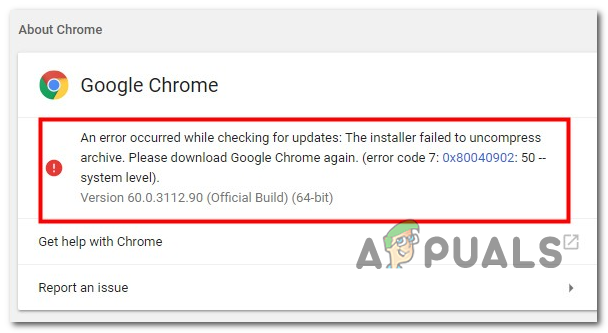
In some cases, this problem will occur due to a series of stuck Chrome processes that are unable to establish connections with the Google download server. In this case, a restart or a series of commands that will kill every involved process should fix the issue.
If your A/V solution has recently resolved a browser hijacker threat (or a similar malware rooted in your Browser), it’s possible that it also ended up quarantining some files used during the updating process. If this scenario is applicable, you should use a powerful uninstaller to remove every leftover file, then install the latest version of Chrome manually.
Kaspersky AV and a few other 3rd party A/V might end up blocking communications with the Google update server due to a false positive. In this case, whitelisting the Chrome processes or uninstalling the overprotective suite should fix the issue.
Method 1: Taskkill every stuck Chrome process
As it turns out, one of the most common instances that will trigger this process is a selection of stuck Chrome processes that will inhibit the browser’s ability to update itself. This typically appears for users that are using hibernation or sleep instead of the regular shut down option.
In this case, you can start by doing a simple reboot and try to update after the next startup is complete.
If that’s not an option or the problem is still persisting, you should proceed by using the ‘taskkill’ command in an elevated CMD window in order to force-close every Chrome process that might be hung.
Here’s a quick guide on using the ‘taskkill’ command to close every Chrome process:
- Ensure that Google Chrome and any associated instances are completely closed.
- Press Windows key + R to open up a Run dialog box. Next, type ‘cmd’ inside the text box, and press Ctrl + Shift + Enter to open up an elevated Command Prompt window.

Running the Command Prompt Note: When you see the UAC (User Account Control), click Yes to grant administrative privileges.
- Once you’re inside the elevated CMD, run the following commands in order and press Enter after each one to kill every involved Chrome process:
taskkill /im chrome.exe /f taskkill /im googleupdate.exe /f taskkill /im google*.exe /fi “STATUS eq RUNNING” /f taskkill /im google*.exe /fi “STATUS eq UNKNOWN” /f taskkill /im google*.exe /fi “STATUS eq NOT RESPONDING” /f
- After every command has been successfully processed, close the elevated CMD prompt, open Google Chrome and attempt to update again to see if the problem is resolved.
In case you’re still seeing the Error Code 0x80040902 when attempting to update your Google Chrome browser, move down to the next potential fix below.
Method 2: Using an uninstaller software
As it turns out, this particular issue can also occur due to some corrupted Chrome data that is interfering with the updating function. This typically occurs after an A/V software successfully detects and removes parts from your Chrome browser in order to contain an infection caused by a browser hijacker.
In this case, the recommended fix is to use powerful uninstalling software to remove Google Chrome along with every piece of remnant data, then do a clean install of the latest version of Chrome. When it comes to doing so, there are a few 3rd party tools that you can use. IObit Uninstaller, CCleaner and Revo Uninstaller.
We used Revo Uninstaller in the guide below, but feel free to use whichever uninstalling software you feel most comfortable with
Here’s a quick step-by-step guide on doing a powerful uninstall on Google Chrome and then installing the latest version:
- Visit this link (here) and download the latest free version of Revo Uninstaller by clicking on the Download button.
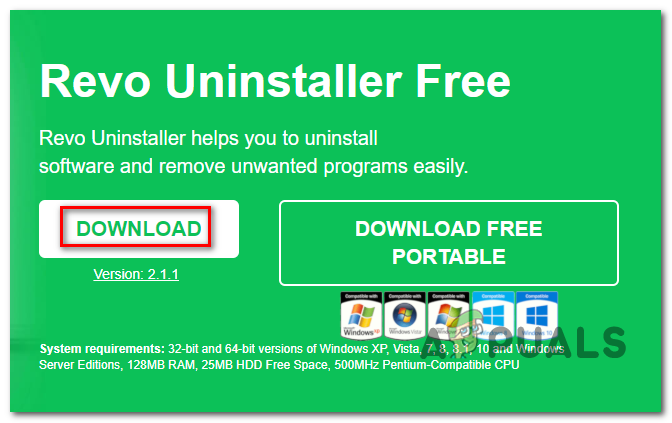
Downloading the latest version of Revo Uninstaller Note: Avoid the portable version since it’s not as effective as the regular version.
- Once the installer executable is downloaded, double-click on it and follow the on-screen prompts to complete the installation.
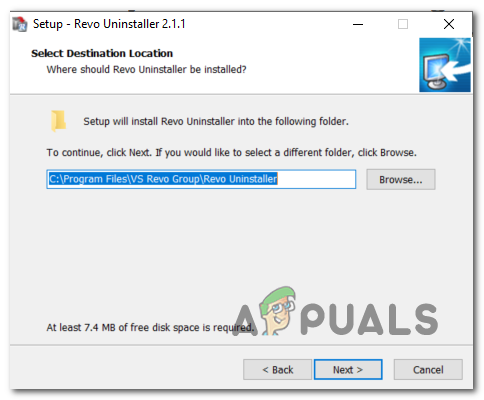
Installing the Revo Uninstaller Note: Click Yes at the User Account Control window to grant admin access to the installer.
- Once you’re inside the Revo Uninstaller app, select the Uninstaller tab and scroll down through the list of installed applications until you locate the Google Chrome entry.
- Once you locate the correct entry, select Google Chrome and click the Uninstall button from the top of the application.
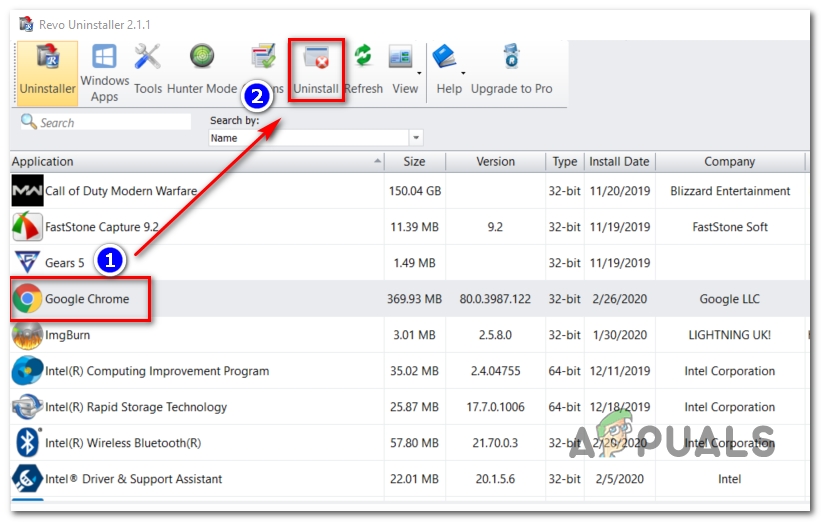
Uninstalling the Chrome application - Inside the next window, wait until the restore point is created, then select Advanced from Scanning modes and click on Scan to remove every leftover file.
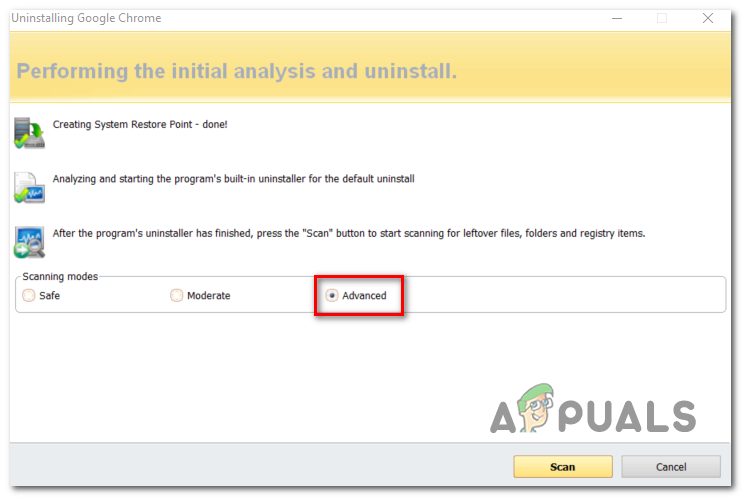
Uninstalling Google Chrome - Follow the rest of the prompts to complete the installation, then restart your computer manually.
- Once the next startup sequence is complete, visit this link (here) with Edge or IE and click on Download Chrome to get the latest version.
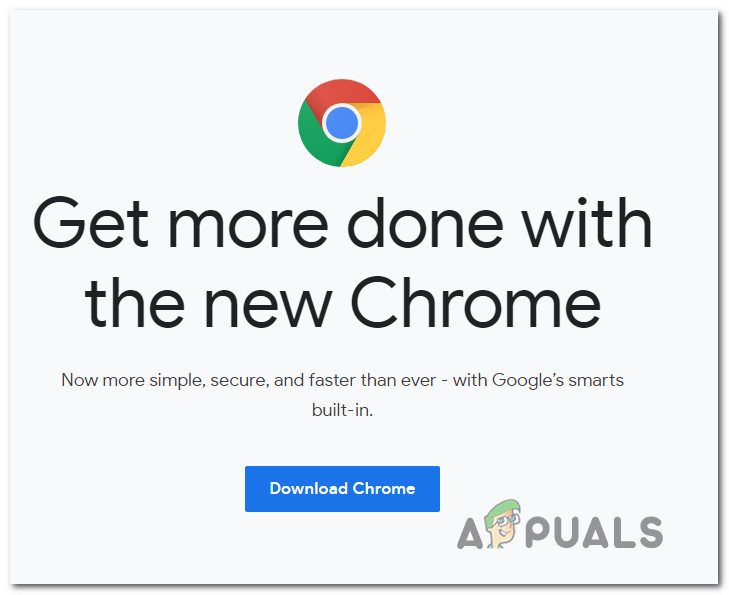
Downloading Google Chrome - Once the installer is downloaded, open it and follow the on-screen prompts to install the latest available version of Google Chrome.
In case the same Error Code 0x80040902 is still persisting, move down to the next fix below.
Method 3: Disable or Uninstall 3rd party suite (if applicable)
According to some affected users, the Update Failed Error Code 0x80040902 on Chrome can also be caused by an overprotective AV suite. Most commonly, Kaspersky Antivirus is reported for blocking the updating function on Chrome, but there might be other AV solutions that exhibit the same behavior.
If this scenario is applicable to your current situation, you have two options:
- Whitelist every Chrome process from your 3rd party Antivirus or Firewall in order to prevent it from interfering with the updating function.
- Uninstall the 3rd party antivirus altogether and go for a more permissive security suite (Windows Defender or a different 3r party AV)
Option 1 is specific depending on the AV tool that you’re using. You can either search online for steps that will allow you to do it or disable the real-time protection while updating Google Chrome.
Most 3rd party AV suites will allow you to disable the real-time protection directly from the Taskbar menu. Simply right-click on your AV icon and look for an option that stops the AV from actively maintaining your network communications. The name of this option will be different from tool to tool.
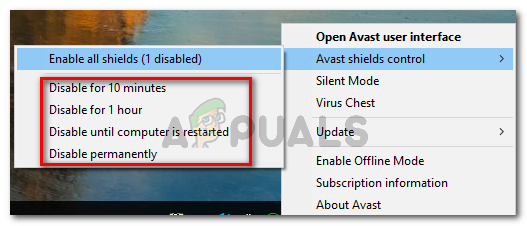
If Option 1 is off the table, here are some step-by-step instructions that will allow you to uninstall the 3rd party AV or firewall from your computer:
- Press Windows key + R to open up a Run dialog box. Next, type ‘appwiz.cpl’ and press Enter to open up the Programs and Features menu.

Opening Programs and Features - Inside the Programs and Files menu, scroll down through the list of installed applications and locate the 3rd party AV suite that you’re using and you want to uninstall. Once you see it, right-click on it and click on Uninstall from the newly appeared context menu.
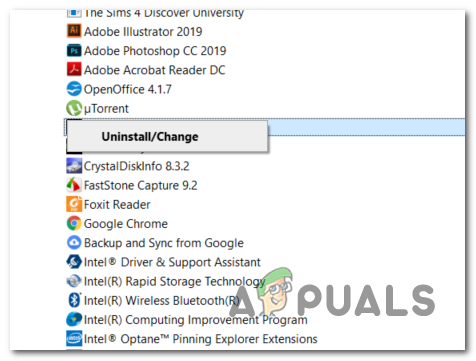
Uninstalling Avast Firewall - Inside the uninstallation screen, follow the on-screen prompts to complete the uninstallation, then restart your computer.
Note: Additionally, you can follow this article (here) to ensure that you’re not leaving behind any leftover data that might still block your connection (highly recommended for 3rd party firewalls) - At the next startup, attempt to update Google Chrome again and see if the issue has been resolved.





